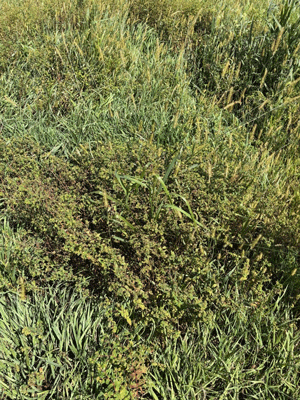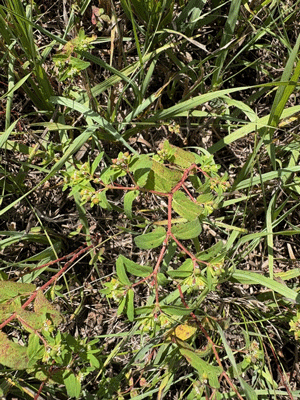In the past few weeks, questions have come in about managing spurge species in pastures and hayfields, especially where stands were thinned by fall armyworm damage. Spurges don’t compete well with healthy forage, so they usually aren’t a problem, and chemical control isn’t often needed. However, the sap is an irritant and can be toxic if ingested by animals. Thus, dense and/or large areas of infestation should be controlled. In Kansas, the three species most commonly seen are spotted spurge, prostrate spurge, and nodding spurge, with nodding spurge being the one most likely to show up in pastures and hayfields (Figures 1 and 2). The other two are more often found in lawns, gardens, or along sidewalks. This article will supplement information shared last week about general weed control and annual brome control in damaged cool-season grass pastures and hayfields.

Figure 1. Nodding spurge growing in a cool-season forage stand damaged by fall armyworms. Photo credit to Rod Schaub of Frontier District.

Figure 2. Close-up of nodding spurge growing in thinning, cool-season grass. Notice the more upright growth pattern. Photo credit to Rod Schaub of Frontier District.
Identification
All three plants are summer annuals that can germinate and emerge in a wide range of environments. Table 1 lists identifying characteristics of the three plants. Like others in the spurge family, such as toothed spurge and snow on the mountain, all three species exude milky sap when the stems are broken. Spotted and prostrate spurge are very similar and even considered to be one species by some scientists. Inconspicuous flowers are found at the base of leaves throughout the summer, and all three species are prolific seed producers. In suitable conditions (warm and wet), seeds that fall from the plant will germinate; in unsuitable conditions, seeds will remain dormant until next spring. Much like other weeds, it is important to control the seed bank and promote forage production with a good fertility program.
Table 1. Characteristics of spotted, prostrate, and nodding spurge.
|
|
Spotted spurge |
Prostrate spurge |
Nodding spurge |
|
Distribution |
Throughout Kansas |
Eastern Kansas |
Throughout Kansas |
|
Stems |
Prostrate, pink, hairy, up to 20 inches long, does not root at nodes |
Prostrate, pink, hairy, up to 20 inches long, roots at nodes |
Green and red, up to 30 inches tall, hairs on upper nodes |
|
Leaves |
Opposite, egg-shaped to elliptic, with a red spot at the base, hairy, serrated margins, 1/8 to 2/3 in long |
Opposite, egg-shaped, red spot at the base, hairy, margins may be serrated, 1/8 to 2/3 in long |
Opposite, oblong, few hairs, margins irregularly toothed, 1 to 12/3 inches long |
|
Flowers |
Inconspicuous, at base of leaves in the upper stem, appear clustered |
Inconspicuous, at base of leaves in the upper stem, single or in pairs |
Inconspicuous, at base of leaves in the upper stem |
|
Fruit/seeds |
3 seeds contained in a three-lobed capsule |
3 seeds contained in a three-lobed capsule |
3 seeds contained in a three-lobed capsule |
Management
During establishment, infestations can be reduced in fall seedings compared to spring, due to an environment that is not conducive to germination of the weed seeds. Mowing will not be effective, as these plants are adapted to low-growing environments.
Products that contain pendimethalin (Prowl H2O, others) can suppress the emergence of spurge species when applied before germination. Postemergence options include herbicide triclopyr (Remedy Ultra, others) and fluroxypyr (Vista, others), and imazapic (Plateau, others).
Sarah Lancaster, Extension Weed Science Specialist
slancaster@ksu.edu
Tina Sullivan, Northeast Area Agronomist
tsullivan@ksu.edu
Tags: pastures weed control hayfields spurge